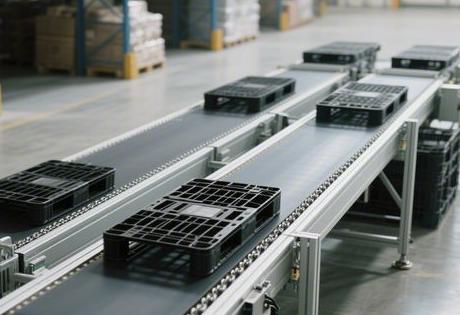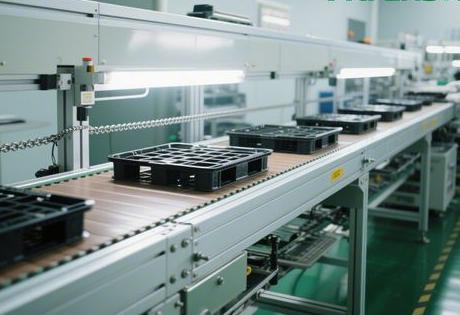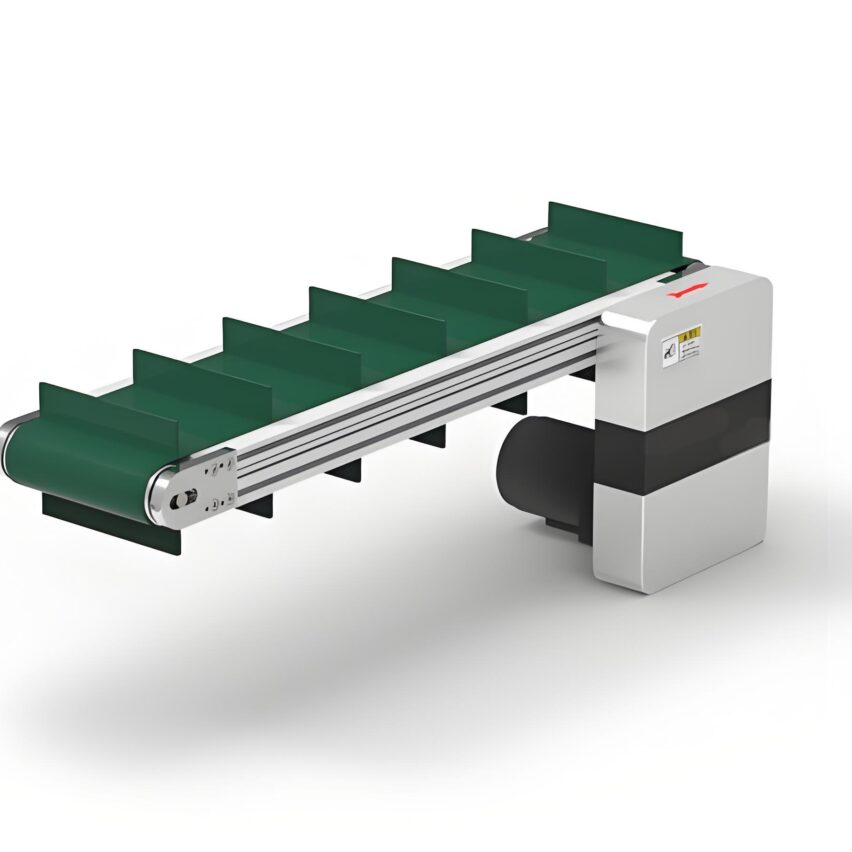I. Engineering philosophy of right-angle steering: from spatial compromise to temporal folding
Conventional production lines rely on 90-degree steeringCombination of jacking translators + loop line bodiesIn addition to taking up 40% extra space, each turn takes more than 15 seconds. The core breakthrough of the 90-degree turning speed chain is thatCompression of steering functions into a single module::

- 3D Stacking Architecture: Multiplier chain and rotating pallet are nested vertically (multiplier chain on top, pallet underneath), turning radius is reduced to 1/3 of the traditional solution, and the layout area of the production line saves 35%;
- Torque-speed decoupling: Manganese-copper alloy gear set (attenuation rate >15dB) drives the steering mechanism, completing 90° steering in 2 seconds, a 6-fold speed increase compared to the loop scheme;
- quantum level positioningThe taper pin mechanism works in tandem with the magnetic encoder to lock the positioning error within ±0.1mm, completely eliminating the risk of workpiece collision.
case of sabotageThe measured data of Gree Intelligent Factory shows that after adopting the right-angle turn doubling chain, the logistics path of the new energy vehicle battery pack production line is shortened by 62 metres/piece, and the capacity of a single day is increased by 120 pieces, which is equivalent toSave 27.6 kilometres of ineffective journeys per year.
II. Mechanical reconfiguration: quantum entanglement of differential chains and steering gears
1. The speed-doubling nature of differential chains
The multiplier chain's ability to increase speed stems fromRoller-roller diameter ratio(D/d):

- Velocity formula: Tooling board speedV = (1 + D/d) × Vcable length (= 1
Theoretical 3x speed is achieved when D/d=2; - Turning loss control: The lateral friction of the rollers surges 300% when steering at right angles, through theDouble-row roller structure(inner steel core + outer PEEK) stabilises the real growth rate at 2.8 times;
- Dynamic slip compensation: A PID algorithm is used to adjust the motor phase angle at the moment of steering to counteract the 10% speed fluctuation caused by centrifugal force.
2. Thermodynamic game for steering gears
face a right-angled turnEntropy Increase Dilemma of Thermal Expansion and Wear::
| sore point | Traditional programmes | Innovative programmes |
|---|---|---|
| 150°C heat distortion | Engineering plastic expansion 0.08mm | Yin steel guide (coefficient of expansion 1.2 x 10-⁶/K) |
| acid corrosion | Monthly corrosion rate >0.1mm | Hastelloy chain plate (pH <2) |
| cornering shock | 20kN kinetic energy without cushion | Hydraulic servo damper (kinetic energy reduction 70%) |
III. Materials Revolution: The Nano Battlefield Against Entropy Increase
Three major material defections and suppression in the right-angle turning area::
- mutiny by abrasion: Lateral friction of the rollers increases by 300% when steering, and the life of the nylon rollers is only 800 hours.Tungsten carbide surface layer (HRC60)Press the wear rate down to the traditional 1/5;
- thermal expansion revolt: Micrometre-scale deformation induced by localised high temperatures of 150 °C →Gradient thermal design: Tungsten carbide with a thermal conductivity of 110 W/m-K + Yin steel substrate with a coefficient of expansion of 1.2 × 10-⁶/K;
- Lubrication Rebellion: dry friction due to high temperature evaporation of grease →Self-repairing bushings: Microporous inlay of molybdenum disulphide solid lubricant for 6000 hours of maintenance-free operation.
personal insight: Failure data from the world's Top 10 plants reveals that the 65%'s steering failures stemmed from thermal management rather than mechanical overloads - a sign that the main battleground for future competition lies in thematerial lattice scale, rather than macro-structures.
IV. Scenario adaptation: from Earth factories to deep space manufacturing
1. Zero Contamination Ballet for Electronics Cleanrooms
- Non-magnetic stainless steel chain(Magnetic permeability <1.01): Eliminate iron filings contamination, Class 10 cleanroom compliance;
- Quick release sterilisation cover: 90 seconds for disassembly and support for weekly deep sterilisation.
2. A sharp turnaround in steel in the heavy industry
- 3-tonne bias load resistant topology: Dual hydraulic buffers to absorb 20kN impact force, aluminium profile frame (intrinsic frequency > 120Hz) to suppress resonance;
- Anti-corrosion solutions for wind turbine towersThe annual corrosion rate of Hastelloy chain plate in pH <2 environment is <0.01mm.
3. Deep-space validation of the Moon base
The fatigue strength retention rate of titanium aluminium intermetallic compound (Ti₃Al) sprocket at -80℃~250℃ temperature difference>90% for theMars siteProvides space-level turning solutions.
V. Technological Singularity: Quantum Sensing and 4D Printing's Descending Strike
The current three major ceilings and 2025 breakthrough weapons::
| bottlenecks | breakthrough technology | performance jump |
|---|---|---|
| Speed > 8m/min offset | quantum gyro stabilisation system | Tolerance convergence to ±0.01mm |
| 100,000 cycles of steering accuracy degradation | Fibre Bragg grating microstrain monitoring | Failure warning 72 hours in advance |
| Rigid structural adaptation barriers | NiTiNOL memory alloy 4D printed links | 10 minutes to switch 25°/90° mode |
Ask Yourself: The Ultimate Three Questions for Right Angle Turn Multiplier Chains
Q1: Why is the traditional loop scheme inevitably obsolete?
A.The Triumph of the Law of Space-Time Economy::
- Area utilisation: 3m diameter ring area vs 0.8m² right angle module, land cost down 60%;
- time foldingShift from 15 sec/time to vs 2 sec/time, saving 3600 man-hours for annual production of one million pieces.
Q2: How to protect the steering mechanism in a strong acid environment?
A.Sandwich armour defence matrix::
- basement layer: Hastelloy (corrosion rate <0.01mm/year);
- mesosphere: Plasma sprayed Al₂O₃ ceramics (porosity <0.5%);
- surface layer: PTFE penetration coating (coefficient of friction <0.05).
Q3: What technologies will disrupt the industry in the next five years?
A.Three technological singularities descend::
- Superconducting magnetic levitation steering: Zero contact friction and unlimited theoretical life;
- brain-computer interface control: Steering by operator's intention, response delay <10ms;
- Carbon-entropy equilibrium links: Zero carbon emissions throughout the life cycle, ISO 14067 certified.
Exclusive data insight: the thermodynamic revolution in steering technology
In 2026, right-angle turn modules with integrated quantum sensors will take theFailure downtime compressed to 18 minutesIn the next few years, the global manufacturing industry will save up to420 million kilometres/year--enough to circle the Earth's equator 10,000 times. Humans rewrote the second law of thermodynamics on an atomic scale when Yinsteel rails fought against a 150°C thermal shock with an expansion coefficient of 1.2×10-⁶/K.Each perfect 90° turn is a declaration of anti-entropy etched by engineers in an entropy-increasing universe.













